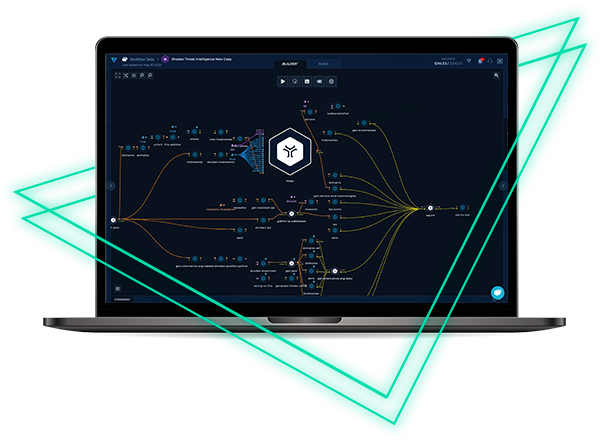Navigating the ever-changing threats in our digital world demands smart and effective strategies. This guide is crafted to be your resource on automated threat intelligence—an important element in staying ahead of cyber risks. Here, you'll find straightforward explanations and insights into how automated processes can help detect and act on potential cyber threats quickly and efficiently.
Automated threat intelligence is about using technology to identify risks and defend against them quickly. It's about making sure your organization is prepared before threats even arise. With platforms like Trickest, you gain access to powerful tools that make this proactive approach possible. Trickest helps the process of turning data about potential cyber threats into clear plans for keeping your systems safe. With Trickest workflows, you can proactively and continuously discover exposed credentials, tokens, API secrets, passwords, and keys to minimize possible security risks.
As we walk you through the basic concepts and practices of automated threat intelligence, we'll touch on how Trickest's platform integrates these into an effective cybersecurity strategy. This guide is designed to inform and equip you with the knowledge to enhance your organization's cyber defenses without jargon or complexity. Let's start building a stronger approach to your cybersecurity endeavors.
What is Threat Intelligence?
Threat intelligence is the process of extracting and investigating data on potential or active threats to an organization's cybersecurity. It's an essential element of modern security strategies, providing detailed insights into the potential dangers of stalking in the digital environment. It also includes the strategies, tools, and processes used to identify, analyze, and respond to security threats. Threat Intelligence teams inform security teams about the nature of threats, providing the necessary insights for them to tailor defensive strategies.
The Necessity of Threat Intelligence
In today's interconnected world, understanding the tactics of cyber attackers is critical. Threat intelligence empowers security teams with knowledge that helps them make faster and smarter decisions. Trickest's platform uses open-source tools to build the most powerful intelligence, providing a clear picture of digital threats and enabling teams to act before threats impact the organization's operations.
Types of Threat Intelligence
Understanding the various forms of threat intelligence is key to implementing a strong security framework. Diverse and multifaceted, threat intelligence comes in various types, each having a unique purpose within an organization:
-
Strategic Threat Intelligence: Broad insights useful for shaping high-level security policies, long-term security planning, and organizational decision-making.
-
Tactical Threat Intelligence: Provides SOC teams with detailed tactics, techniques, and procedures (TTPs) of threat actors and is typically utilized by those managing the day-to-day defense of a network.
-
Operational Threat Intelligence: Provides in-depth details on specific attacks or campaigns, aiding in an immediate and effective response to active threats.
-
Technical Threat Intelligence: Delivers immediate, actionable data such as IP addresses, domain names, and file hashes associated with threats. This intelligence is crucial for threat detection systems, helping identify and block potential security breaches as they arise quickly.
The Threat Intelligence Lifecycle
A structured lifecycle guides the transformation of raw data into meaningful threat intelligence:
-
Planning and Direction: Setting clear goals and scope for intelligence collection based on specific security needs.
-
Collection: Gathering data from diverse and reliable sources.
-
Processing: Organizing data into a usable format, ready for in-depth analysis.
-
Analysis: Interpreting the data to extract actionable intelligence and inform security decisions.
-
Dissemination: Delivering intelligence to relevant stakeholders in a clear and understandable format.
-
Feedback: Using stakeholder feedback to refine and improve the intelligence collection process.
Automated Threat Intelligence with Trickest
Trickest's Offensive Security Orchestration Platform is revolutionizing the approach to threat intelligence automation. Aimed at empowering large enterprises' internal Red and Purple Teams, MSSPs, SecOps teams, bug bounty hunters, and penetration testers, Trickest offers a unique and powerful platform for building, managing, orchestrating, and executing custom offensive security automation workflows. Key features of Trickest's Platform for threat intelligence include:
-
Visual Offensive Security Orchestration Framework: Trickest's Visual Workflow Builder replaces traditional, complex command-line processes with a user-friendly, low-code environment. This innovative approach allows security engineers to easily create custom methodologies and integrations, elevating the threat intelligence process to a new level.
-
Extensive Open-Source Tools Library: Users gain access to a vast collection of over 300 open-source offensive security tools. These tools can be customized or utilized in building workflows from scratch. Trickest also boasts over 90 ready-made workflow templates, catering to needs in Attack Surface Management, Content and Secret Discovery, Threat Hunting, and Vulnerability Detection.
-
HyperScalable Execution Engine & Managed Cloud Infrastructure: Trickest provides a scalable, managed infrastructure, simplifying the setup and configuration processes. This feature ensures complete coverage of digital infrastructure, regardless of size, without the need for extensive manual effort or human resource allocation.
-
Collaborative Offensive Security Environment: The platform encourages collaboration by enabling teams and colleagues to join forces seamlessly. This collaborative feature encourages sharing workflows and results, fostering a productive problem-solving and knowledge-exchange environment.
-
Custom Solution Engineering: The Trickest expert team offers tailored solution engineering services for specific, unique requirements. This allows for the creation of personalized scanners and workflows, merging the platform's extensive capabilities with our deep, specialized expertise.
Threat Intelligence Workflows
Trickest's Library collection of pre-built workflows is meticulously designed to automate continuous threat intelligence processes. These workflows enable users to proactively detect a wide range of potential threat indicators, such as exposed credentials and API secrets, effectively mitigating security risks before they can impact systems and operations. Trickest is also used as OSINT Automation Framework and empowers users to gather extensive data, providing the tools needed to build and deploy scalable OSINT frameworks customized for specific investigative needs.
Extensive OSINT
This workflow can be very helpful for threat analysts as it enables them to monitor the activities and movements of malicious actors, identify potential vulnerabilities present in an organization's systems, and gain insights into the techniques, tactics, and procedures (TTPs) utilized by adversaries. By closely analyzing this data, analysts can get a deeper comprehension of the threat environment and develop effective strategies for defending against potential attacks.

Shodan Threat Intelligence
Organize information from Shodan API into categories, retrieve alternative organization names, gather hostnames, web servers, take screenshots, and perform a port scan on all collected IP addresses.

Other use cases:
-
Continuous Attack Surface Management: ASM workflows enable users to uncover their attack surface, configure, schedule, and scale recon operations, discovering vulnerabilities, hostnames, web servers, and more.
-
Vulnerability Detection Automation: The platform supports ongoing scanning for bugs, outdated software, weak credentials, and more, including support for specific scans like CVE-2023-3519.
-
Content and Secret Discovery: The platform's workflows dive beyond surface-level assets, uncovering underlying content and potential attack vectors.
You can discover more workflows in our product documentation.
Open-Source Tools for Threat Intelligence
With hundreds of tools available in Trickest's Library for offensive security orchestration, here are only some of them integrated into the platform that supports detailed threat analysis and help security teams uncover and address potential vulnerabilities with precision:
Spiderfoot
SpiderFoot is a tool designed for automating the collection of open-source intelligence (OSINT) for threat intelligence and attack surface mapping. It boasts compatibility with numerous data sources and employs various analytical techniques to simplify data exploration. Offering both a user-friendly web interface through its built-in web server and a command-line option for those who prefer it, SpiderFoot is versatile and accessible. It is developed in Python 3.
Dnstwist
Discover how easily users might mistakenly type in your domain incorrectly and the potential security risks that come with it. Dnstwist helps you identify similar-looking domains that attackers could use against you, detecting possible instances of typo squatting, phishing, fraud, and unauthorized use of your brand, making it a vital source for focused threat intelligence.
It automates the process of uncovering domains that could be used maliciously against your company, creates a detailed list of domain name variations, checks if any are registered, and assesses them for malicious intent.
Shodan-python
Shodan stands out as a unique search engine specifically designed for finding Internet-connected devices. Similar to how Google indexes websites, Shodan indexes devices. The official Python library and command-line interface for Shodan make it straightforward for developers to tap into this wealth of information, allowing for the automation of tasks and seamless integration with other tools.
With Shodan, you can perform detailed searches and execute bulk IP lookups promptly. It also supports the Streaming API, enabling real-time data streaming directly from the Shodan firehose. Network alerts, also known as the private firehose, are part of its offering, improving security monitoring capabilities. The Library allows for the management of email notifications and fully implements an exploit search API, giving users the tools to search for known vulnerabilities. For extensive data analysis, Shodan facilitates bulk data downloads and provides access to its DNS database for comprehensive domain information, all manageable through its efficient command-line interface.
BBOT
Bighuge BLS OSINT (BBOT) Tool truly elevates OSINT automation for the hacking community. This framework is Python-based and stands out for its ability to perform a complete OSINT with just a single command.
Drawing inspiration from the capabilities of Spiderfoot, BBOT advances further by integrating features like scans across multiple targets, impressive speed with asyncio, and advanced Natural Language Processing (NLP) for creative subdomain variations. The toolset BBOT offers covers everything from discovering subdomains and scanning ports to taking web screenshots, identifying vulnerabilities, and beyond.
In head-to-head comparisons, BBOT consistently surpasses similar subdomain enumeration tools by a significant margin—achieving a performance edge of approximately 20-25%.
Benefits from Cyber Threat Intelligence
The integration of cyber threat intelligence into an organization's security strategy brings a multitude of advantages that can fundamentally transform its approach to cybersecurity. Here are some of the key benefits:
-
Enhanced Decision-Making: Cyber threat intelligence empowers organizations and teams with critical, timely information that informs decision-makers at every level. By providing a clear understanding of the nature and potential impact of threats, leaders can make more strategic decisions about resource allocation, security investments, and risk management.
-
Strategic Anticipation of Threats: By shifting focus from a traditionally reactive stance to a proactive one, continuous threat intelligence enables organizations to anticipate and prepare for potential attacks. This forward-looking approach not only helps to prevent security breaches but also minimizes the impact of those that may occur.
-
Optimized Resource Allocation: In increasingly complex cyber threats, efficiently utilizing resources becomes crucial. Cyber threat intelligence helps organizations identify the most significant threats and allocate their technological and human resources where they are needed most. This results in a more streamlined and effective security operation that can dynamically adapt to the changing threat landscape.
-
Reduced Incident Response Time: With actionable intelligence at their fingertips, security teams can reduce the time it takes to respond to incidents. Quick response is vital in mitigating damage and reducing the chances for attackers to exploit vulnerabilities in the system.
-
Strengthened Security Core: Cyber threat intelligence provides insights that lead to stronger defenses. By understanding adversaries' tactics, techniques, and procedures, organizations can improve their security controls and strategies, leading to a more potent security posture that can withstand the evolving tactics of cybercriminals and malicious hackers.
-
Compliance and Risk Management: Regulatory compliance is a significant concern for many organizations. Cyber threat intelligence helps ensure security measures comply with relevant laws and regulations by providing up-to-date information on the latest cybersecurity standards and practices.
-
Competitive Advantage: A strong cybersecurity strategy can be a competitive differentiator in an interconnected global market. By having threat intelligence practices, organizations can protect their reputation, maintain customer trust, and avoid the financial losses associated with data breaches.
FAQ
What is threat intelligence automation?
Threat intelligence automation refers to the use of technology to collect, analyze, and distribute information about cyber threats without manual intervention, allowing for real-time threat detection and response.
What is AI threat intelligence?
AI threat intelligence involves incorporating artificial intelligence to process huge amounts of data, identify patterns, and predict future cyber threats, enabling organizations to stay ahead of potential security breaches.
What are the three types of threat intelligence data?
The three types of threat intelligence data are:
-
Tactical Intelligence: This is the most immediate form, focusing on indicators of compromise (IOCs) such as malicious IPs, URLs, and file hashes. It's technical and often automated, allowing for quick consumption, but it tends to have a short lifespan due to the rapidly evolving threat landscape.
-
Operational Intelligence: This form provides insights into the "who," "why," and "how" of threat actors, offering context on their tactics, techniques, and procedures (TTPs). Operational intelligence requires human analysis and is key for those in proactive security roles, such as SOC analysts.
-
Strategic Intelligence: The most complex form, strategic intelligence, provides a high-level view of the cyber threat landscape, influencing business decisions and long-term security strategy. It requires an in-depth analysis of geopolitical conditions and other macro-level factors that could impact an organization's cybersecurity.







